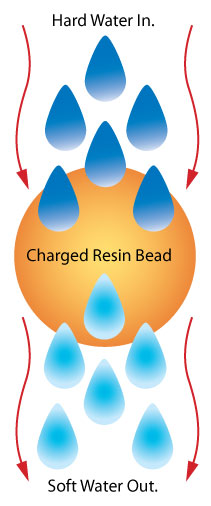A water softener is packed with resin beads. Each of these beads is "charged" with regenerant. Hard water with calcium and magnesium flows through this resin and, in a process called ion exchange, the hardness ions in the water trade places with soft ions on the resin beads. The result is soft water.
Over time, the resin beads will become covered with calcium and magnesium ions, diminishing their capacity to soften hard water. Through a process called regeneration, water is automatically flushed through the system with a concentrated amount of regenerant. Now the resin beads pick up the soft ions from the regenerant in exchange for the hardness on the beads. Dirt and rock are sent down the drain. With the resin beads "recharged," the system goes back to service, providing the whole house with clean, soft water.
Smaller Is SmarterTM
Water softeners come in all shapes and sizes and bigger definitely does not mean better. AquaMaster uses fine mesh resin - smaller beads that actually provide more surface area to soften water. This resin is vacuum-packed to allow maximum capacity in a minimum of space. Plus, our patented Directional Flow Screen system helps ensure that no resin bead goes unused. Our screens and whole-house dirt and sediment filter also protect the resin bed, so we don't need to waste space on "freeboard" which is the empty area in conventional units that permit a churning of resin during regeneration to release dirt, sediment and hardness.


